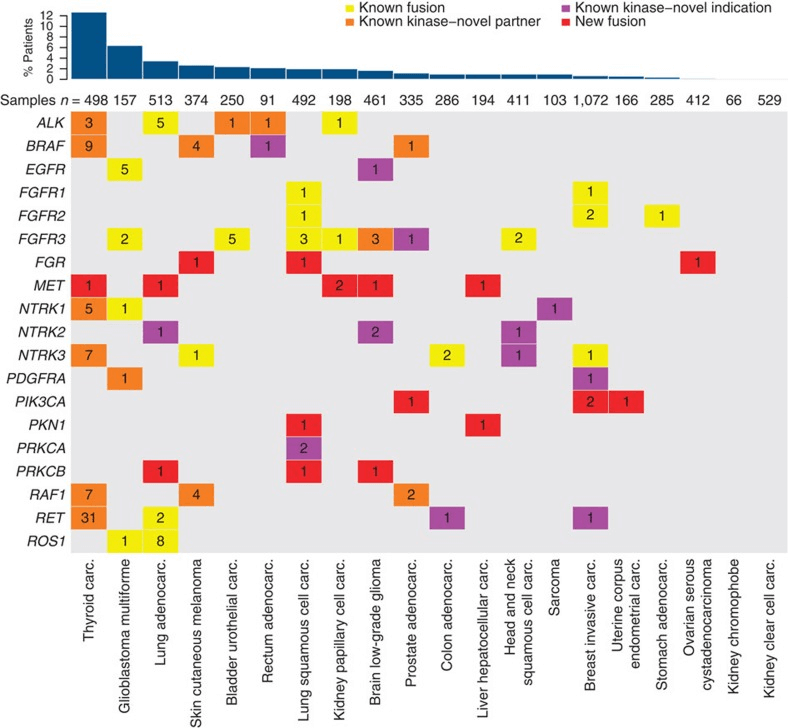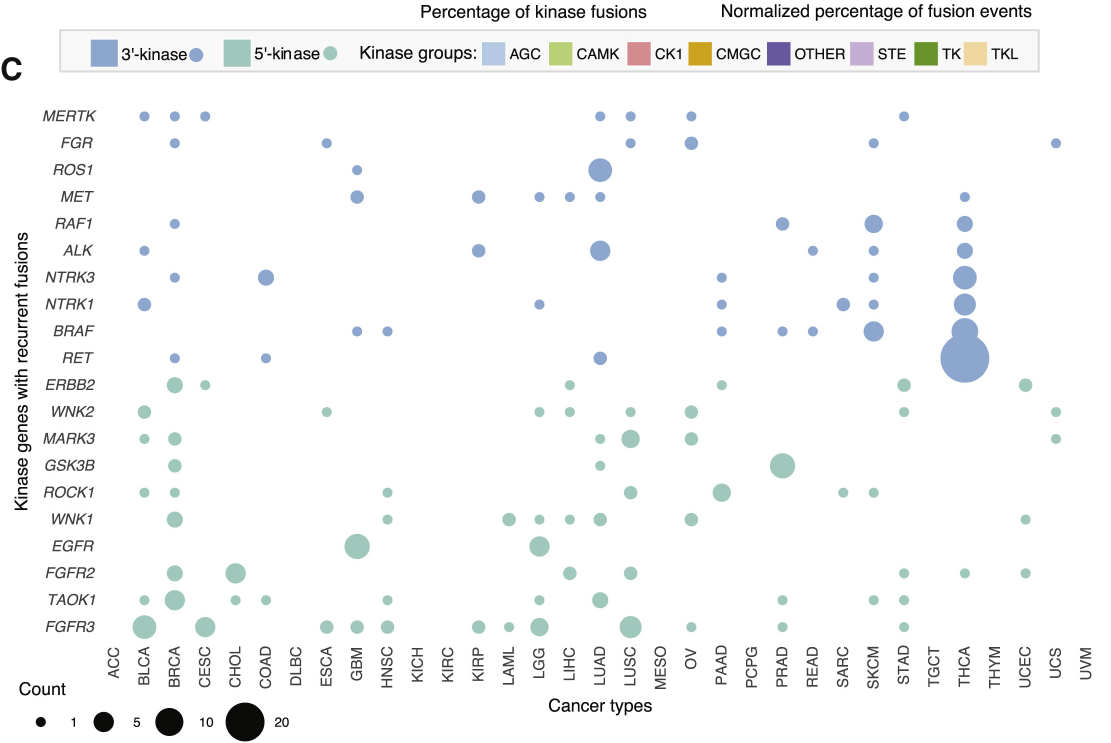To date, many studies have focused on identifying SNPs, insertions, deletions, and copy number alterations in cancer genomes. Although such genomic alterations account for a large portion of the typical tumor mutational burden, gene fusions also play a key role in tumorigenesis. Most known cancer translocation events involve ALK, BRAF, EGFR, FGFR1, 2 and 3, NTRK1/2/3, PDGFRA, PRKCA, RAF1, RET, ROS1, etc. Gene fusions or translocations have the potential to produce functionally altered chimeric proteins. These events may also rearrange gene promoters to amplify oncogenic function through protein overexpression or reduce the expression of tumor suppressor genes, especially kinase fusions. Kinase fusion cellular signaling pathways promote gene transcription, cell growth, proliferation, differentiation, and survival, although these pathways also play a role in the regulation of cellular metabolism. Kinase fusions are abnormal genomic alterations in tumor cells caused by the abnormal rearrangement of the translocation of two genes, one of which encodes a protein kinase. At present, the hot spots for kinase fusions focus on fusion methods and the discovery of new fusions. Our molecular testing platform offers a variety of in situ hybridization-based testing services to help researchers test hypotheses at the single-cell level or in histological contexts.
 Fig 1. The landscape of recurrent kinase fusions in solid tumors. (Nicolas Stransky, et al. 2014)
Fig 1. The landscape of recurrent kinase fusions in solid tumors. (Nicolas Stransky, et al. 2014)
Testing Services for Kinase Fusion and Novel Fusion Discovery
Our testing services can be used for further validation analysis of sequencing data, as well as the characterization of spatial information of transcripts at the single-cell level. Signals involving kinases that are more studied in cancer include tyrosine kinases, serine/threonine kinases, and the like. Our solution can be used for further analysis to identify recurrent, potentially oncogenic fusion events involving kinases. Currently, an important prerequisite for the realization of personalized medicine is the determination of the complete genomic profile of the patient, further increasing the confirmation of tumor heterogeneity. Our test serves these studies. Importantly, the powerful co-expression analysis capabilities of our platform can provide gene fusion detection at the same time through protein-level expression analysis. The ability of multi-level analysis helps customers save time and samples.
Some examples of kinase fusions emerging from current research;
- ALK fusions, including EML4 - ALK, TFG - ALK, and STRN - ALK. It has been found in various cancer types including lung adenocarcinoma, colorectal cancer, breast cancer, renal cell carcinoma, renal medullary carcinoma and thyroid cancer;
- ROS1 fusions, which have been found in samples from lung adenocarcinoma, glioblastoma;
- BRAF fusions, including AGK - BRAF, SND1 - BRAF, MACF1 - BRAF, TAX1BP1 - BRAF, and CDC27 - BRAF. It has been found in cancers including prostate, melanoma and thyroid;
- RAF1 fusions, including AGGF1-RAF1 fusions;
- Discover more new fusions. . .
 Fig 2. Protein kinase fusions in cancer. (Qingsong Gao, et al. 2018)
Fig 2. Protein kinase fusions in cancer. (Qingsong Gao, et al. 2018)
Creative Bioarray provides customized visualization solutions for gene mapping, transcript characterization, etc. of kinase fusions in cancer, helping researchers characterize kinase-related gene fusion events in cellular malignant events. Our molecular platforms provide individual analysis or co-expression analysis of genes, transcripts, and proteins, working with you to find the best solution for your needs. If you are interested in our FISH services, please contact us for cooperation. We look forward to cooperating with you in the near future.
References
- Stransky, Nicolas, et al. "The landscape of kinase fusions in cancer." Nature communications 5.1 (2014): 1-10.
- Gao, Qingsong, et al. "Driver fusions and their implications in the development and treatment of human cancers." Cell reports 23.1 (2018): 227-238.


 Fig 1. The landscape of recurrent kinase fusions in solid tumors. (Nicolas Stransky, et al. 2014)
Fig 1. The landscape of recurrent kinase fusions in solid tumors. (Nicolas Stransky, et al. 2014) Fig 2. Protein kinase fusions in cancer. (Qingsong Gao, et al. 2018)
Fig 2. Protein kinase fusions in cancer. (Qingsong Gao, et al. 2018)


